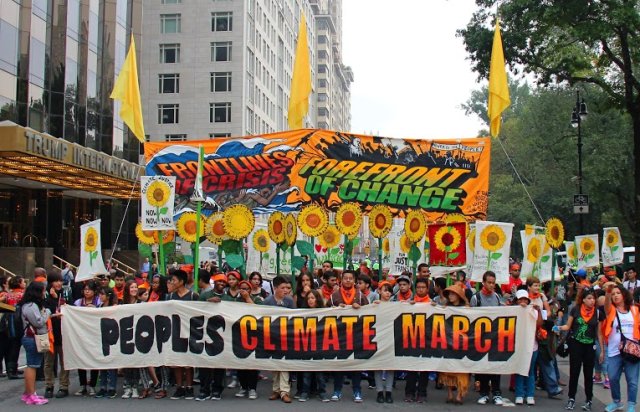
The largest demonstration to date on the need to stop global warming was held in New York City on September 21.
It was the largest of the global demonstrations in more than 160 cities that day ahead of a United Nations climate summit held on September 23 in New York.
The historic protest brought together a wide range of groups and individuals in a march through Manhattan, two days before heads of states gathered to discuss the issue.
The marchers took to the streets to raise the alarm. The vast throng stopped for a moment of silence in honour of those who have already died around the world as a result of catastrophes linked to global warming.
Then the entire crowd erupted in a tremendous roar to literally sound the alarm. It was directed at the heads of state, not in support of them — for the obvious reason that these governments have repeatedly failed to address the problem.
The 26 marching bands blared their instruments. All kinds of groups brought their own noisemakers. But the main outcry was from the throats of the hundreds of thousands of ordinary people there to make their opinions known.
There were all kinds of groups present, including indigenous peoples from the US, Canada and Latin America, who have borne the brunt of ravages inflicted by the big energy companies, from the tar sands of Canada to the forests of Ecuador ruined by Texaco.
Representatives of indigenous peoples from around the world took part in the march. Photo by Edward Leavy Jr.
Some unions were present. A leader of health care workers explained that many of its members are nurses from the Philippines, hard hit by ever bigger hurricanes.
Students from many universities and colleges raised the issue of their struggle to get their institutions to divest from fossil fuel. People from areas hit by the “side effects” of fracking carried their own signs. There were too many groups to list.
Above: A protester highlights corporate funding of George Mason University. Below: Actor Mark Ruffalo with an anti-fracking placard. Photos by Edward Leavy.
Individuals and groups all brought their own posters, many hand-made. Some built large floats which joined the march.
This was a truly grass-roots march, not a top-down affair. The march organisers from different environmental groups encouraged everyone to bring their own banners and literature, and raise their own concerns.
Anti-war group Code Pink's contingent on the march. Photo by Edward Leavy Jr.
The result was that all aspects of the problem of climate change were expressed.
As momentum built for the march, it inspired similar marches to be organised around the world that day. It also resulted in solidarity actions being held in cities around the US.
The activist wing of the environmental groups, including 350.org (named for the goal of cutting carbon dioxide in the atmosphere to 350 parts per million), initiated the action. But as momentum for the march rose, even the conservative groups, such as the Sierra Club, endorsed the march.
Another group that initiated the march and was key to organising it was System Change Not Climate Change (SCNCC).
This group is a coalition of socialist groups and individual radicals, who target the capitalist system itself as the cause of climate change and advocate socialism as the only long-term solution. At the same time, SCNCC joins actions targeting immediate demands against corporations responsible for emitting greenhouse gases and other forms of environmental destruction.
SCNCC formed its own contingent in the New York march. Prominent in SCNCC are members of the International Socialist Organisation and Solidarity.
The role played by SCNCC and other socialist groups in the march, and their acceptance as part of the broader environmental movement, marks a step forward.
A major reason for this is the impact of the Great Recession and the subsequent stagnation that has hit all working people hard. The Occupy movement, which targetted the wealthiest 1% and implicitly capitalism itself, is not forgotten.
Also, every single target of the environmental movement — from the XL pipeline, tar sands oil, mountain top removal, Big Oil and Gas, fracking, to pollution of rivers, etc. etc — is a capitalist corporation. It does not take a big leap to generalise from these separate targets to realising that the capitalist system itself is to blame.
The day after the big march in New York, more than 1000 people took part in a rowdy sit-in on Wall Street that was explicitly anti-capitalist. About 100 people were arrested after eight hours.
Their action was called “Flood Wall Street” — a reference to the actual flooding of the area during Hurricane Sandy.
Above and below: Flood Wall Street march and civil disobedience. Photos by Edward leavy Jr.
In the San Francisco Bay Area where I live, it was a small chapter of SCNCC that initiated the proposal for a solidarity action to coincide with the New York march.
The groups involved included the ISO and Solidarity, together with the Committees of Correspondence for Democracy and Socialism. Individual socialists also played a leading role.
At first, it looked like any action here would be small. But as the momentum built for the New York march, more groups joined in and it mushroomed to over 100 endorsers.
Like in the New York action, there was a grassroots enthusiasm that resulted in many colorful and ingenious manifestations culminating in a rally of about 4000 in Oakland. SCNCC and other socialist groups had tables doing a brisk business.
The anti-climax was the UN meeting two days after the march. As the 400,000 had expected, the meeting mostly featured hot air that probably did more to contribute to global warming than fight it.
Like the article? Subscribe to Green Left now! You can also like us on Facebook and follow us on Twitter.